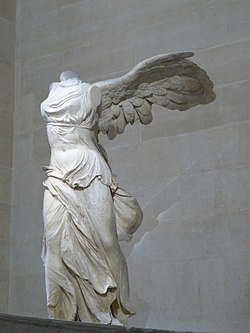Winged Victory of Samothrace
 |
|
| Year | c. 200–190 BC |
|---|---|
| Type | Parian marble |
| Dimensions | 244 cm (96 in) |
| Location | Louvre, Paris |
|
|
The Winged Victory of Samothrace, also called the Nike of Samothrace, is a marble Hellenistic sculpture of Nike (the Greek goddess of victory), that was created about the 2nd century BC. Since 1884, it has been prominently displayed at the Louvre and is one of the most celebrated sculptures in the world. H.W. Janson described it as "the greatest masterpiece of Hellenistic sculpture", and it is one of a small number of major Hellenistic statues surviving in the original, rather than Roman copies.
The Winged Victory of Samothrace, discovered in 1863, is conventionally thought to have been made to celebrate a naval victory in 190 BC. However, there are objections to this dating, and alternative victories ranging from the Battle of Salamis in 306 BC to the Battle of Actium in 31 BC have been proposed as the event being celebrated. Datings based on stylistic evaluation have been equally variable, ranging across the same three centuries, but perhaps tending to an earlier date.
It is 8 feet (2.44 metres) high. It was created not only to honor the goddess, Nike, but also to honor a sea battle. It conveys a sense of action and triumph as well as portraying artful flowing drapery, as though the goddess were descending to alight upon the prow of a ship.
Modern excavations suggest that the Victory occupied a niche above a theater and also suggest it accompanied an altar that was within view of the ship monument of Demetrius I Poliorcetes (337–283 BC). Rendered in grey and white Thasian and Parian marble, the figure originally formed part of the Samothrace temple complex dedicated to the Great gods, Megaloi Theoi. It stood on a rostral pedestal of gray marble from Lartos representing the prow of a ship (most likely a trihemiolia), and represents the goddess as she descends from the skies to the triumphant fleet. Before she lost her arms, which have never been recovered, Nike's right arm is believed to have been raised, cupped round her mouth to deliver the shout of Victory. The work is notable for its convincing rendering of a pose where violent motion and sudden stillness meet, for its graceful balance and for the rendering of the figure's draped garments, compellingly depicted as if rippling in a strong sea breeze. Similar traits can be seen in the Laocoön group which is a reworked copy of a lost original that was likely close both in time and place of origin to Nike, but while Laocoon, vastly admired by Renaissance and classicist artists, has come to be seen as a more self-conscious and contrived work, Nike of Samothrace is seen as an iconic depiction of triumphant spirit and of the divine momentarily coming face to face with man.
...
Wikipedia
